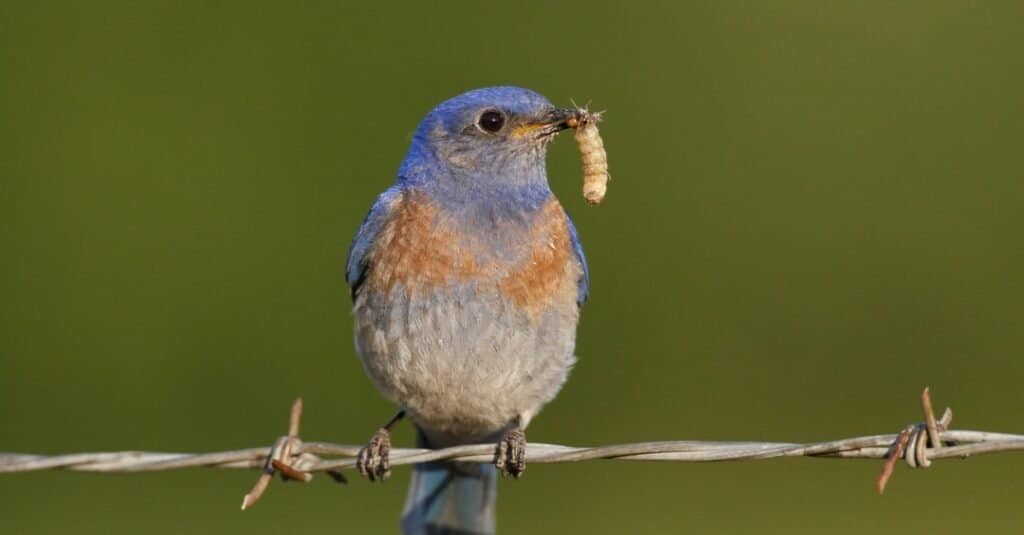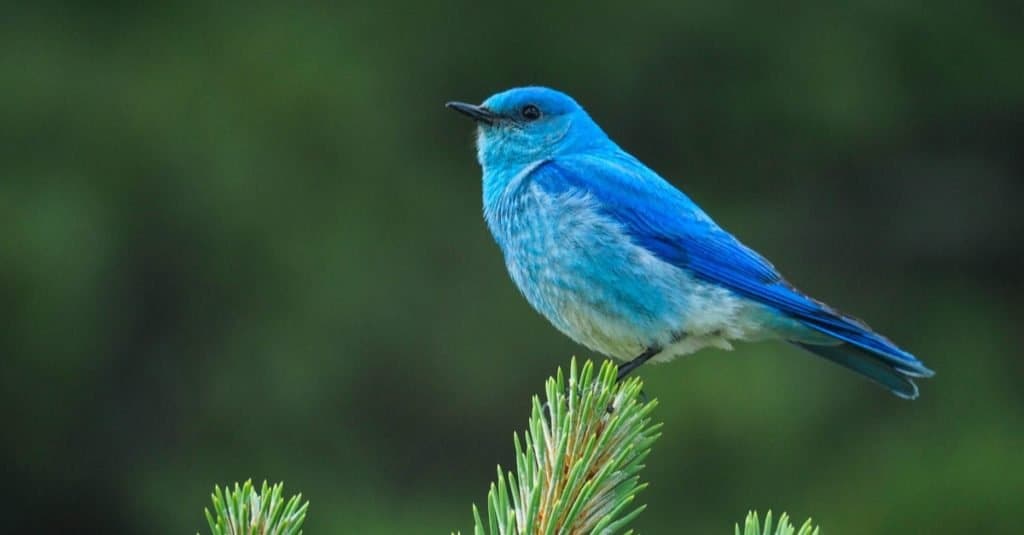The animal kingdom provides us rainbows of color with butterflies, chameleons, and clownfish, but birds can put on a spectacular display. A rainbow of colors can be found in the bird family, including the peacock, toucan, and macaw. So, have you ever wondered what kinds of birds have blue plumage? Indeed, nature never fails to surprise and stun us with its beauty, and when it comes to birds, bluebirds are undeniably among the most beautiful avian creatures we may ever lay our eyes on. But are there bluebirds in Texas? If so, what types are they?

Texas, the second-largest state by size and population density, is not surprisingly filled with picturesque landscapes that host wonderful wildlife. Thankfully, one of these colorful animals is the bluebird, a doughty little bird carrying a beautiful melody. The eastern bluebird, western bluebird, and mountain bluebird are 3 different species of bluebird, and luckily, all three types are present in Texas. Below, we will explore the 3 types of bluebirds flying across Texas, their diet, habitat, and other fascinating facts.
3 Types of Bluebirds in Texas
The eastern, western, and mountain bluebird species reside in Texas at various periods of the year. A drop in the population of bluebirds across the country has been attributed to harsh weather, habitat loss for nesting, and intense competition with sparrows and starlings. The bluebird has long been regarded as a sign of joy and warm weather. Additionally, it is a proficient predator and omnivore.
1. Eastern Bluebird

Bluebirds aren’t actually blue and only appear blue because of a lighting illusion.
©Bonnie Taylor Barry/Shutterstock.com
Birdwatchers love the eastern bluebird because it is noticeable and typically simple to find. The areas where eastern bluebirds spend the entire year are where birdwatchers stand the highest chance of seeing them. These adorable and well-liked small birds are regarded as spring harbingers; in some locations, you can hear them singing even while snow is on the ground. They are less endangered than many other creatures, and their population is growing.
Appearance
The typical length of an eastern bluebird is 7 inches, and its wingspan ranges from 9.8 to 12.6 inches. Bluebirds aren’t actually blue and only appear blue because of a lighting illusion. The juvenile’s and the female’s coloring keeps them concealed from predators. Since no bird can produce blue pigment the way a bird can produce red or yellow pigment, any blue in the plumage results from the light striking proteins arranged in a specific way in the feathers.
Habitat
Eastern bluebirds favor open woodlands, farms, highway medians, and orchards in Texas. Breeding eastern bluebirds are found in eastern Texas, the United States, Canada, and Mexico. During the winter, bluebirds migrate to the southernmost portion of their territory.
As it dives after a worm, the bird may be spotted perched on a fence or a phone wire. Open, regularly burned pine savannas, beaver ponds, mature yet open woodlands, and forest openings were likely among their original ecosystems. Currently, they are most frequently seen around backyards, pastures, suburban parks, agricultural areas, and even golf courses.
Population
Around 20 million birds, according to biologists, make up the population of eastern bluebirds. They are not considered endangered, and most places have had good population growth.
Diet
Insects and other small invertebrates like snails and grubs make up about 68% of the bluebird’s diet. The bluebird’s diet is advantageous to people because many of these species are detrimental to plants. The bluebird will live off of berries found in the woods during the winter when it is difficult to find animal protein. This includes honeysuckle berries, which are lethal to humans. Ponds and streams provide bluebirds with water, and they use birdbaths for drinking and bathing.
Fun fact: Eastern bluebirds were once a rarity in Texas!
Eastern bluebird populations began to decline about 100 years ago due to a drastic reduction in the number of nesting places that were accessible. Since bluebirds are classified as cavity nesters, they only build their nests inside completely enclosed cavities, save for the entrance hole.
These birds cannot excavate their nest cavity, which furthers the problem. Therefore, in the wild, they only use holes in trees that previous seasons’ woodpeckers have carved out.
Over time, fewer nesting places became available due to various factors, including human activity, such as the removal of rotting trees, the use of newer, more durable fence posts, and the introduction of house sparrows and European starlings.
2. Western Bluebird

Western bluebirds lay their eggs in cavities.
©iStock.com/mooninwell
In contrast to many other members of the thrush family, western bluebirds lay their eggs in cavities. The development of nest boxes has helped bluebirds in some areas of their ranges, although many secondary cavity-nesting species have suffered from the disappearance of natural cavities.
Appearance
Males can be distinguished by their dazzling blue heads, wings, and tails, as well as their rust-colored breasts. The feathers of females are more brown and gray and are duller overall. The lazuli bunting, which looks somewhat similar, has chestnut on the breast and blue upper parts. However, tiny lazuli buntings have pronounced white wing bars and conical bills.
Due to the proximity of this species’ and eastern bluebirds’ typical ranges in Texas, it might be challenging to tell them apart. Males with vivid plumage are simple to distinguish from plainer females, who might be challenging.
Habitat
In Texas, open woodlands and the edges of forests are good places to look for these birds. Western bluebirds are rarely seen in fields and meadows like other bluebird species, and these birds like the forests instead. Additionally, meadows, prairies, or pastures are home to these birds. They also appreciate habitats that contain a variety of shrubs, grasses, and trees, such as burned regions, woodlands, or locations where logging has thinned the forest cover.
Population
According to the North American Breeding Bird Survey, Western bluebird populations have been widespread and stable from 1966 to 2019. Partners in Flight calculates the species’ global breeding population at 7.1 million and gives them a Continental Concern Score of 9, which is the lowest possible score.
Diet
Most western bluebirds are insectivores and frequently eat grasshoppers, caterpillars, flies, ants, and beetles. Small fruits including elderberries, mistletoe, currants, grapes, and poison oak berries are among the vegetables they enjoy.
3. Mountain Bluebird

Mountain bluebirds are diminutive songbirds with rounded heads and stomachs, narrow beaks, and black, sinewy legs.
©MTKhaled mahmud/Shutterstock.com
The mountain bluebird is the recognized state bird of Idaho, and Nevada, but is also found in Texas. Some Native Americans revere these birds’ feathers as sacred emblems. Because of its exceptionally vivid blue plumage, this species is commonly referred to as “the bluest of the bluebirds.” Arctic bluebird and ultramarine bluebird are two additional frequent names for this species.
Appearance
Mountain bluebirds are diminutive songbirds with rounded heads and stomachs, narrow beaks, and black, sinewy legs. The differences between the sexes in appearance are obvious. The upper feathers of the males are a vivid blue color, which dwindles to a faint white tone near the lower stomach. Females come in shades of gray, brown, and even light orange. Most birds are roughly the size of some drinking glasses, measuring between 6 and 7 inches.
These bluebirds prefer to stay close to the ground so they may rapidly swoop down and grab their preferred diet: insects. They even maintain a low profile while flying!
Habitat
Mountain bluebirds can be seen throughout the breeding season at altitudes of up to 12,500 feet, as their name would imply. They often fly to lower heights as winter hits. These birds live in open spaces like pastures, meadows, and plains. Additionally, they appreciate habitats with various grasses, shrubs, and trees, such as open woodlands, burned regions, or locations where logging has decreased the forest cover.
The mountain bluebird migrates further and for a longer period than any other bluebird species. Their wintering range reaches as far south as Mexico, and their breeding range reaches as far north as Alaska. Nevada, Utah, California, New Mexico, Colorado, and Arizona have year-round populations. They don’t have a social behavior; however, they seem to migrate in big flocks of up to 50 birds. There are still many unknowns regarding their migratory behavior.
Population
These birds are now categorized as a species of least concern by the IUCN Red List, a key global conservation tracker, necessitating no specific conservation measures. There are thought to be more than 4 million mature individuals still living in the wild, and the numbers seem to rise again after a brief period of relative fall.
Diet
During the winter, the mountain bluebird may often eat seeds and fruits, but most of its food are small invertebrates, including cicadas, caterpillars, crickets, grasshoppers, spiders, and many others. Through controlling insect populations, they play a crucial role in the environment.
These birds do not currently face any major dangers in the wild except predators. The majority of their range is sparsely populated and even has human protection. However, they occasionally face intense competition from other birds for nesting locations. Nesting hollows might not always be accessible, which makes this situation worse. Additionally, they could unintentionally get stuck within PVC pipes and other built objects.
Summary of 3 Types of Bluebirds in Texas
| Name of Bluebird | Habitat | Diet |
|---|---|---|
| Eastern | Open woodlands, farms, and orchards. | Insects and other small invertebrates; sometimes berries. |
| Western | Open woodlands and the edges of forests. | Insects and small berries. |
| Mountain | Pastures, meadows, and plains. | Insects and other small invertebrates. |
The photo featured at the top of this post is © Agami Photo Agency/Shutterstock.com
Thank you for reading! Have some feedback for us? Contact the AZ Animals editorial team.






